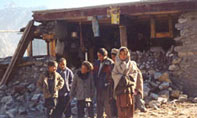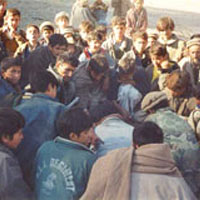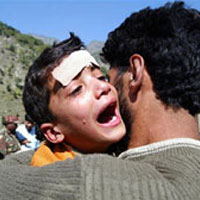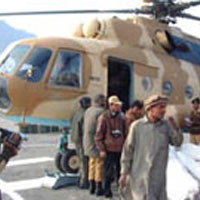- About Us
- Columns
- Letters
- Cartoons
- The Udder Limits
- Archives
- Ezy Reading Archive
- 2024 Cud Archives
- 2023 Cud Archives
- 2022 Cud Archives
- 2021 Cud Archives
- 2020 Cud Archives
- 2015-2019
- 2010-2014
- 2004-2009
 |
On the Scene: The Pakistan Earthquake |
Saturday, 8th October at around 9.00AM local time the earth started to move.
My husband Matthew and I were still asleep when awoken by the bed shaking. Both a bit stunned, we sat up and saw all of the built-ins had been flung open and were flapping back and forth as if the room was possessed. My first fleeting thought was that it was a bomb ' perhaps not a bomb directed at our house but close enough by to produce this shock. As Matthew later noted, why would people bother to bomb the residence of the Second Secretary Political from the Australian High Commission and his wife ' it would hardly impact on world events! Being more disaster savvy than I was, he knew it to be an earthquake. We rushed to the bathroom and hopped into the bath.  This was my great idea. Somewhere in the recesses of my mind where you store information (often useless information) a message went off that said ' earthquake - bath. I have since been told that I got my natural disasters confused and a doorframe would have been more appropriate. After the worst of the tremors had stopped we ran outside onto the lawn. The whole sensation was bizarre. It was as though a giant under the earth had decided to stretch and roll over. At this stage we had no idea of the severity of the quake or the destruction that had been wreaked.
This was my great idea. Somewhere in the recesses of my mind where you store information (often useless information) a message went off that said ' earthquake - bath. I have since been told that I got my natural disasters confused and a doorframe would have been more appropriate. After the worst of the tremors had stopped we ran outside onto the lawn. The whole sensation was bizarre. It was as though a giant under the earth had decided to stretch and roll over. At this stage we had no idea of the severity of the quake or the destruction that had been wreaked.
We now know that at 8:50:38 AM local time, 8th October, 2005 an earthquake measuring 7.6 on the Richter scale occurred unleashing a mass humanitarian disaster. The epicentre was 93 kilometres north of Islamabad close to Muzaffarabad in Pakistan-administered Kashmir. It has been called the largest disaster that Pakistan has ever faced. As of today it is estimated that at least 40,000 people have been killed. This toll is expected to rise. The hardest hit area is Pakistani administered Kashmir. In Muzaffarabad alone 11,000 have been confirmed dead. Reports are saying that the 600,000 people who inhabit Muzaffarabad are sleeping outside, too scared to enter what remains of their buildings.
 Balakot, in North West Frontier Province is the gateway to the Kaghan Valley. The valley has often been described as one of the most beautiful valleys in Pakistan (which is no mean feat given the sheer beauty of the mountains). It is now destroyed. The Pakistani government have said that 3,500 have been killed in the area, but many would consider this a conservative figure. Eyewitness accounts have reported that the centre of the town has been completely obliterated and that aid is coming in a trickle. Parents have been pulling their dead children out of what remained of the schools with nothing but small shovels.
Balakot, in North West Frontier Province is the gateway to the Kaghan Valley. The valley has often been described as one of the most beautiful valleys in Pakistan (which is no mean feat given the sheer beauty of the mountains). It is now destroyed. The Pakistani government have said that 3,500 have been killed in the area, but many would consider this a conservative figure. Eyewitness accounts have reported that the centre of the town has been completely obliterated and that aid is coming in a trickle. Parents have been pulling their dead children out of what remained of the schools with nothing but small shovels.
United Nations (UN) Undersecretary General and Emergency Relief Coordinator, Jan Egleand, after visiting Muzaffarabad said that he feared that they were losing the race against time in the small villages, which are still cut off. Twenty per cent of the affected areas are yet to receive any type of help. Out of the remote valleys and mountains people are walking for days on end to reach help. They bring with them horror stories of families and villages completely destroyed. Only those strong enough to walk are making it out, carrying the injured on makeshift stretchers. Sheer desperation has led some aid workers to abandon their trucks and set off on foot to reach the towns before it is too late. Helicopters are unable to reach some areas, as the villages are literally perched on mountains.
 Friends that have been reporting from the hardest hit areas have told me that the enormity of the situation is almost incomprehensible. Aftershocks are still occurring that in some cases has hampered the search effort. It was today announced that tent villages are going to be set up around Islamabad and Rawalpindi to house the two million people who have been left homeless, the first step in the rebuilding.
Friends that have been reporting from the hardest hit areas have told me that the enormity of the situation is almost incomprehensible. Aftershocks are still occurring that in some cases has hampered the search effort. It was today announced that tent villages are going to be set up around Islamabad and Rawalpindi to house the two million people who have been left homeless, the first step in the rebuilding.
This disaster is far from over.
